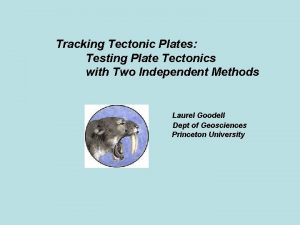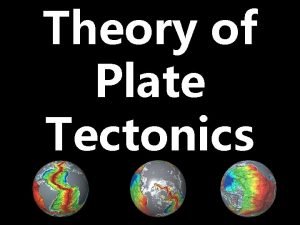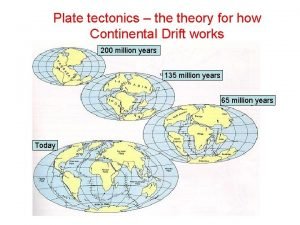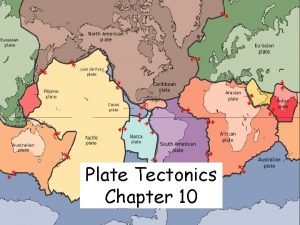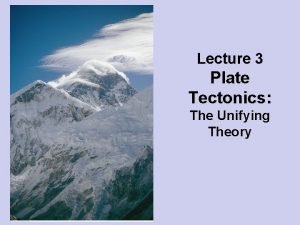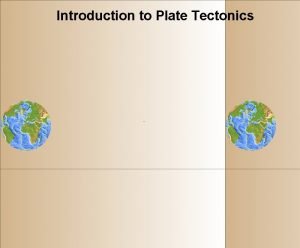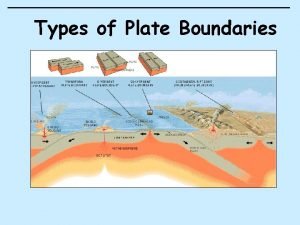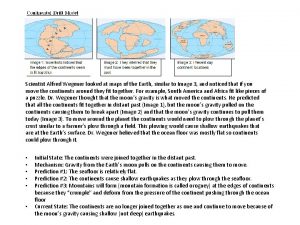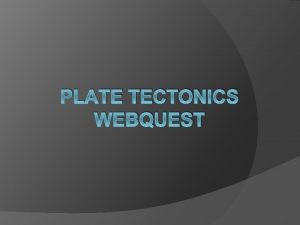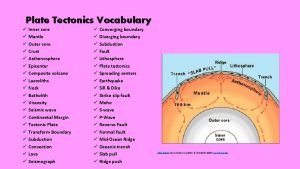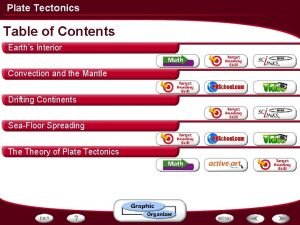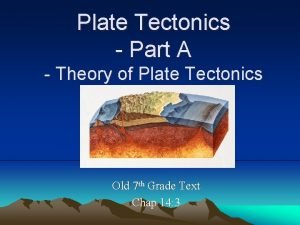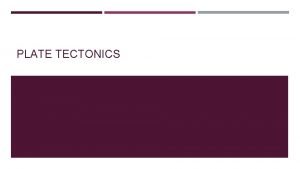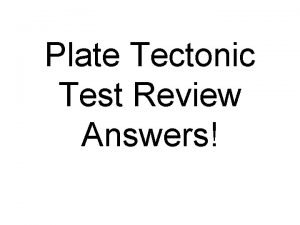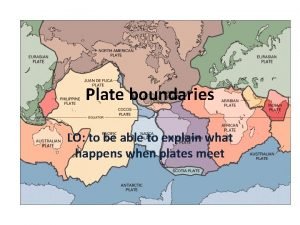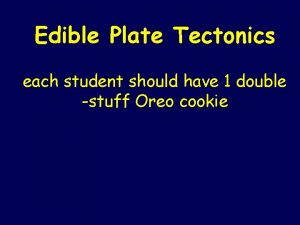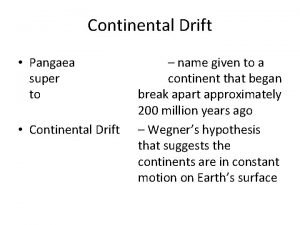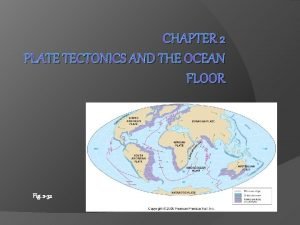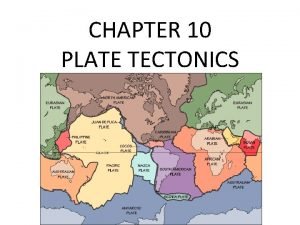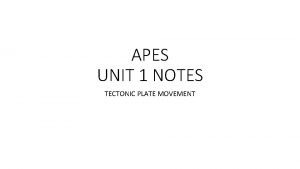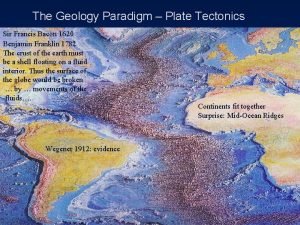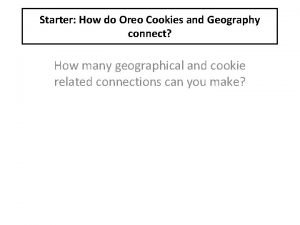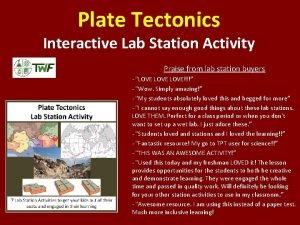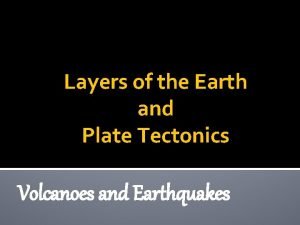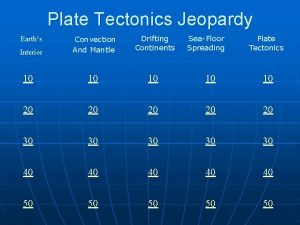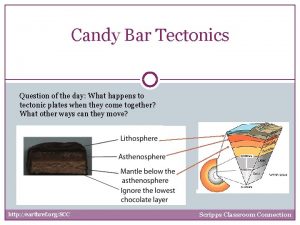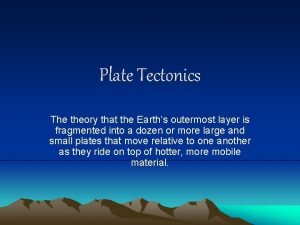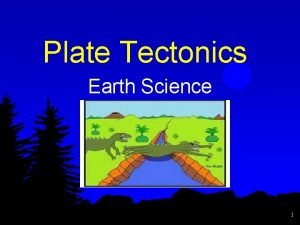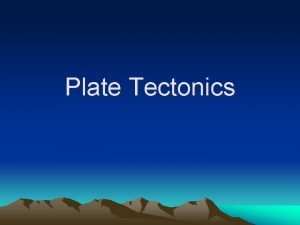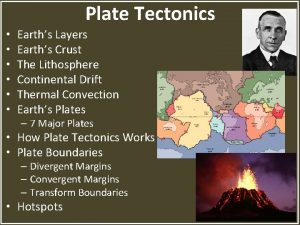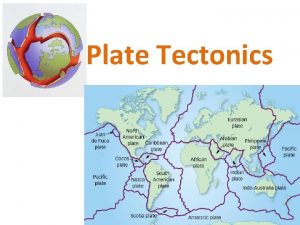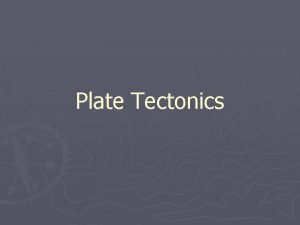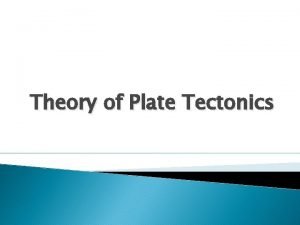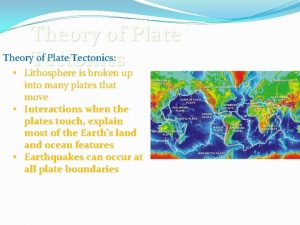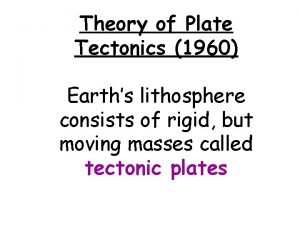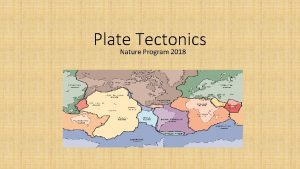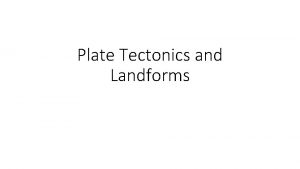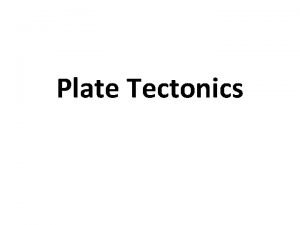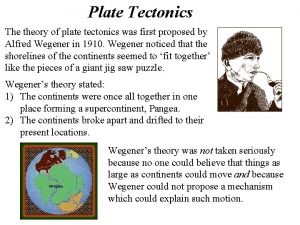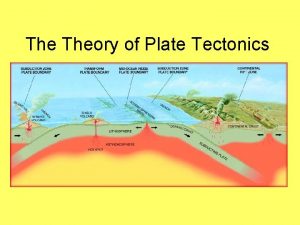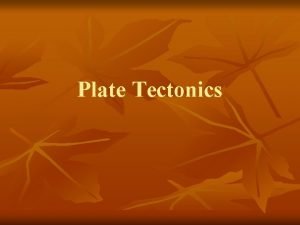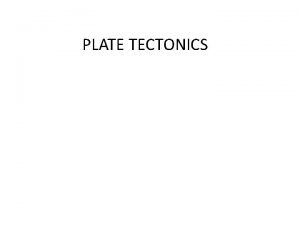Plate Tectonics The theory that the Earths lithosphere


































- Slides: 34

Plate Tectonics The theory that the Earth’s lithosphere is divided into tectonic plates that move around on top of the asthenosphere.

Crust The “plates” of the lithosphere float and move around on the asthenosphere. Mantle Outer Core Liquid Lithosphere – Crust and Upper Layer of the Mantle (asthenosphere) that consists of hot rock of tar -like consistency, which slowly moves Inner Core Solid https: //www. yout ube. com/watch? v=Z 9 Hr 7 V 1 S 0 p. I

Plate Boundary Map

When plates move, they can interact in several ways: • They can move toward each other • They can pull apart from each other • They can slide alongside one another The result of plate movement can be seen at plate boundaries.

Divergent Plate Boundary: two plates are moving apart and new crust is created

Divergent Plate Boundary: Continental Plate When two continental plates spread apart rifts (cracks) begin. These then can become rift valleys. Magma can rise and squeeze between the cracks sometimes forming volcanoes.

Divergent Boundary: Krafla Volcano Iceland

Divergent Boundary Great Rift Valley, Africa

Divergent Plate Boundary: Continental Plate Continental Crust Ridge Continental Plate Continental Crust

Divergent Plate Boundary: Oceanic Plate When two oceanic plates spread apart magma is forced upward pushing the older seafloor away in opposite directions forming a ridge. http: //www. classzone. com/books/earth_science/terc/content/visualizations/es 0 903/es 0903 page 01. cfm? chapter_no=visualization

Divergent Plate Boundary: Oceanic Plate

Divergent Boundary: Mid-Atlantic Ridge

Divergent Plate Boundary: Oceanic Plate Oceanic Crust Mid-Ocean Ridge Oceanic Crust

Convergent Plate Boundary: two plates collide

Convergent Plate Boundary: Continental Plate the crust buckles and pushes upward forming mountains.

Convergent Plate Boundary Continental

Convergent Plate Boundary Continental Earthquakes are common at these convergent boundaries, but volcanoes do not form because there is no, or little, subduction.

Convergent Plate Boundary Continental Himalayan Mountains, Nepal http: //www. classzone. com/books/earth_science/terc/content/visual izations/es 1105 page 01. cfm? chapter_no=visualization

Convergent Plate Boundary Continental Crust Mountains Why no volcanoes?

Convergent Plate Boundary: Oceanic

Convergent Plate Boundary: Oceanic • A colder, denser oceanic plate subducts (goes down), under another oceanic plate into the mantle. • A deep sea trench is created where one plate bends and sinks. • High temperatures cause rock to melt around the subducting plate as it goes under the other plate • Newly formed magma is forced upward along these plate boundaries, forming volcanoes. • Over millions of years, erupted lava piles up until it rises above sea level to form volcanic island arcs.

Convergent Plate Boundary: Oceanic Japan In

Convergent Plate Boundary: Oceanic Underwater Volcanoes and Volcanic Islands Oceanic Crust Trench Oceanic Crust

Convergent Plate Boundary: Oceanic Continental

Convergent Plate Boundary: Oceanic Continental • The denser oceanic plate subducts (goes down), under the continental plate into the mantle. • A deep sea trench is created where one plate bends and sinks. • High temperatures cause rock to melt around the subducting plate as it goes under the other plate • Newly formed magma is forced upward along these plate boundaries, forming volcanoes.

Convergent Plate Boundary: Oceanic Continental http: //www. classzone. com/books/earth_science/terc/content/visualizations/es 0 902/es 0902 page 01. cfm? chapter_no=visualization

Convergent Boundary Andes Mountains, South America

New crust is added at divergent boundaries while it disappears below the surface at the subduction zones of convergent boundaries. https: //www. youtube. com/w atch? v=ryr. XAGY 1 dm. E

Convergent Plate Boundary: Oceanic Continental Volcano Oceanic Crust Continental Crust Trench

Transform Plate Boundary: Plates Slide Past Each Other

Transform Boundary • Plates move in opposite directions or in the same direction at different rates • When one plate slips past another plate suddenly, earthquakes occur • These plate boundaries do not destroy or build up Earth’s crust.

Transform Boundary http: //www. classzone. com/books/earth_science/terc/content/visualizations/es 11 03/es 1103 page 01. cfm? chapter_no=visualization

Transform Boundary: San Andreas Fault in California

Transform Boundary Earthquakes
 Continental drift vs plate tectonics theory
Continental drift vs plate tectonics theory Plate tectonic theory vs continental drift
Plate tectonic theory vs continental drift Plate motion calculator
Plate motion calculator The plate tectonics theory states that
The plate tectonics theory states that Convergent plate boundary
Convergent plate boundary Summarize the theory of plate tectonics
Summarize the theory of plate tectonics Lithosphere definition
Lithosphere definition Unifying theory of plate tectonics
Unifying theory of plate tectonics Theory of plate tectonics
Theory of plate tectonics Plate tectonics vs continental drift
Plate tectonics vs continental drift Convergent boundary with subduction
Convergent boundary with subduction Compare continental drift and plate tectonics
Compare continental drift and plate tectonics Webquest plate tectonics
Webquest plate tectonics Plate tectonics vocabulary worksheet
Plate tectonics vocabulary worksheet Seafloor spreading material at trenches
Seafloor spreading material at trenches Plate tectonics definition
Plate tectonics definition Driving force of plate tectonics
Driving force of plate tectonics Concept map plate tectonics
Concept map plate tectonics Arthur holmes contribution to plate tectonics
Arthur holmes contribution to plate tectonics Plate tectonics test review answer key
Plate tectonics test review answer key Constructive plate boundary diagram
Constructive plate boundary diagram Edible plate tectonics
Edible plate tectonics Pangaea
Pangaea From now
From now Chapter 10 plate tectonics
Chapter 10 plate tectonics Plate tectonics definition apes
Plate tectonics definition apes Francis bacon plate tectonics
Francis bacon plate tectonics Oreo plate tectonics
Oreo plate tectonics Plate tectonics interactive lab
Plate tectonics interactive lab Oreo tectonics
Oreo tectonics Two regions of the mantle
Two regions of the mantle Plate tectonics game board
Plate tectonics game board Candy bar tectonics
Candy bar tectonics Plate tectonics
Plate tectonics Tectonic plates
Tectonic plates


